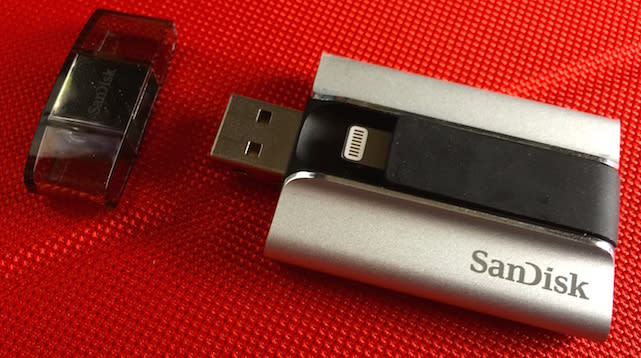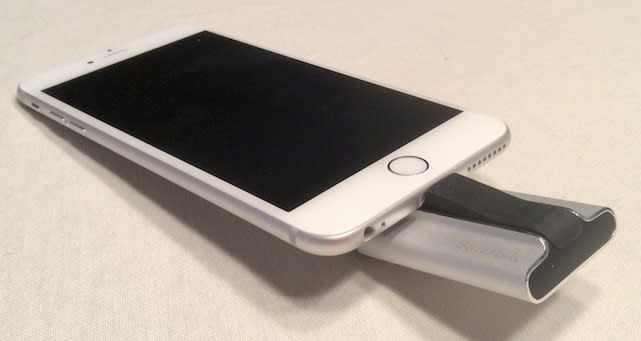SanDisk iXpand Flash: Bring extra storage to your iOS device

As much as we all love our iOS devices, there's something that some Android and Windows Phone devices usually have that would be really nice to have on an iPhone or iPad - expandable storage. Some of those devices have an SD, mini-SD, or micro-SD card slot into which you can drop an inexpensive flash card, making it simple to transfer files between devices or store tons of content (photos, videos, etc...) on a removable card. Now SanDisk is bringing some of that flexibility to Lightning-equipped iOS devices with the new iXpand Flash drive (US$59.99 for 16 GB, $79.99 for 32 GB, and $119.99 for 64 GB).
While it seems unique, the iXpand Flash really isn't something new. A few years ago, I reviewed the PhotoFlash i-FlashDrive HD, an 8 GB to 64 GB solution with an accompanying app that added a file system to iOS for storing just about any type of file. The device worked well; in fact, I still use it regularly to move masses of files between Mac and iPad.
SanDisk's solution will have a bit more clout, primarily it's from a company that is huge and well known. SanDisk has a presence in 300,000 retail storefronts, and the company has a 36 percent global revenue market share in the flash drive world, so the brand has gathered both familiarity and trust.
Design
In terms of design, the SanDisk iXPand Flash is much more polished than the PhotoFast solution. The former was a white plastic device with a 30-pin Dock connector on one end and a USB connector on the other, with a USB to Lightning adapter thrown on for the newer devices. Unfortunately, that design meant that in many situations, cases had to be removed from iPads and iPhones in order for the connector to be plugged in.
Not so with the iXpand Flash. It features a sleek metal-looking body with a flexible Lightning adapter that is stowed in one side. Atop the device is the USB connector, protected with a smoked plastic cover.
The whole shootin' match weighs a scant .9 ounce (25.5 grams) and takes up a small volume of about 2.48 x 1.46 x .39 inches (63mm x 37mm x 10mm). It looks good - much better than the somewhat kludgy PhotoFast i-FlashDrive HD - but how does it function in the real world?
Functionality
The idea behind devices like the iXpand Flash is that regardless of how much space you have on an iPhone or an iPad, chances are really good that you're going to take a lot of photos or videos and run out of storage. To offload those photos and videos, you plug the iXpand Flash drive into your iOS device, use the accompanying free iXpand Sync app to grab the content and store it in a folder or folders on the drive, and then optionally use the USB connector to copy the content to a PC or Mac for backup.

I tested beta versions of iXpand Sync on an iPad Air. When the drive is connected and the app is launched, it presents a clean layout showing a group of folders (ASSETS, Documents, Music, Photos, Videos), Mac and PC executables for SanDisk's SecureAccess V2 software, and a couple of QuickStart guides.
One QuickStart guide shows how to plug the drive into a iOS device, as well as how to interpret the tiny LED on the side of the drive. The iXpand Flash drive does have a battery, and a green LED indicates that it is charged, a red LED indicates a low battery state (in which case you plug the drive into a USB port for charging), and a yellow LED indicates that the drive is being charged.
To move something from your device to the drive, you tap the large red plus sign button at the bottom of the iXpand Sync display. You're asked if iXpand Sync has your permission to access your photos, and your photo library is visible once you give the OK. Images can be viewed by individual photos or by albums.
To select an image or file, you simply tap on its thumbnail in the app and a large red check mark appears on it. A large "Select Destination" button appears at the bottom of the screen; tap on it, and you're presented with the file system for the device. You can either tap on one of the pre-created folders, or create a new folder with the tap of a button.
I used three different pre-release versions of the app and ran into some difficulties; after deleting and reloading the app several times, I was finally able to get it to work consistently and properly. I should note that the competing i-FlashDrive app was quite buggy when it first appeared on the App Store, and it has gotten consistently better with time.
One of the app's features includes the ability to do a Camera Sync. This takes all of the images in your Photo Library and saves them to a "Camera Roll Backup" folder the first time it is run, then synchronizes any additions made to the iPhone or iPad by copying those to the drive the next time you connect it. The sync was quite speedy, taking about 17 seconds to copy over ten DSLR images ranging in size from 6 to 10.3 MB in size. The drive had no issues copying some large video files, although it did slow down a bit. There's also a built-in function for transferring contacts to a backup folder, which is always a good idea.
Another useful function of the iXpand Flash is for moving large productivity app files between iOS and Mac or PC. I had a number of Keynote presentations that I needed to move from my Mac to an iPad Air, and it was easy to copy them onto the iXpand Flash, then from the iXpand Flash to the Air.
You can name your drive anything you want - the test device was blessed with my last name - which is actually quite useful if you end up with more than one of the devices.
Conclusion
I was quite pleased with both the design and the functionality of the SanDisk iXpand Flash drive. If I have any complaint, it's that the devices are relatively expensive compared to plain flash drives. For example, I can pick up a SanDisk Cruzer 64GB flash drive for about $30 on Amazon; it's almost highway robbery to charge four times as much for one that's had a Lightning connector and some software added to it. Despite the price tag, the SanDisk iXpand Flash drive is still a useful accessory for anyone who needs to transfer a number of large files between iOS devices and Macs or PCs.
Rating: 3-1/2 stars out of 4 stars possible


